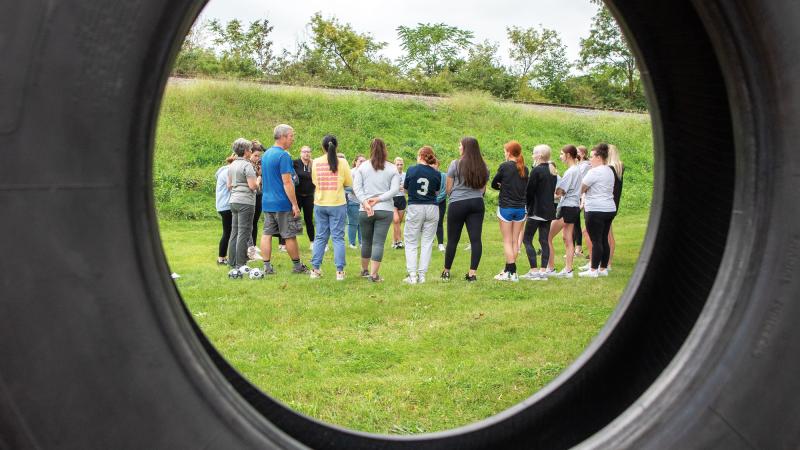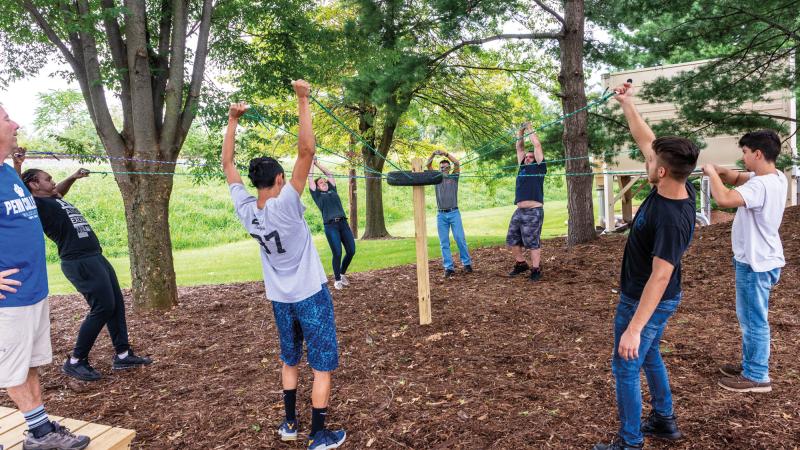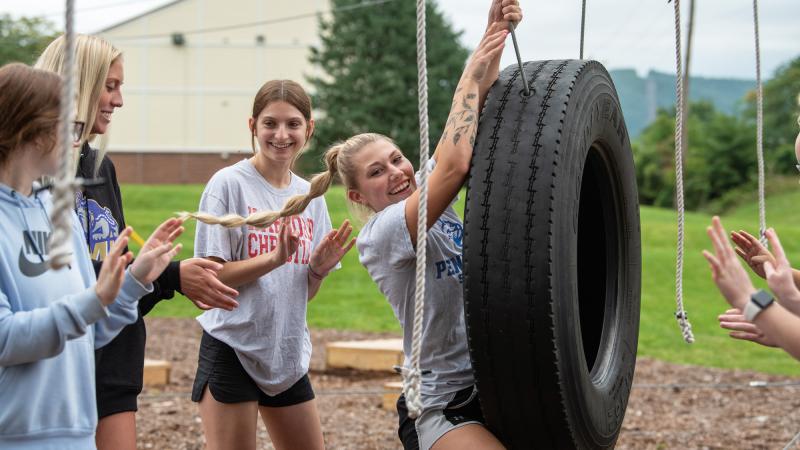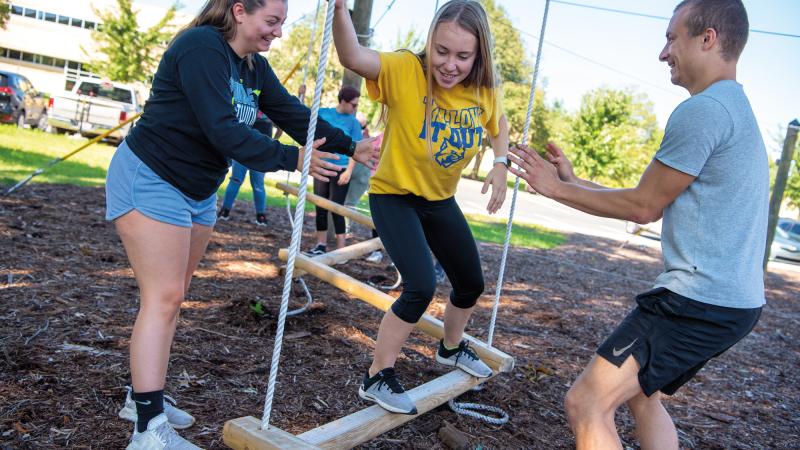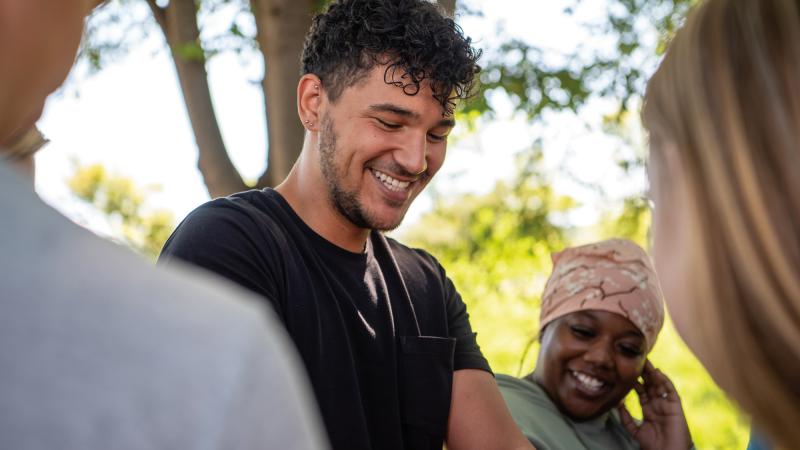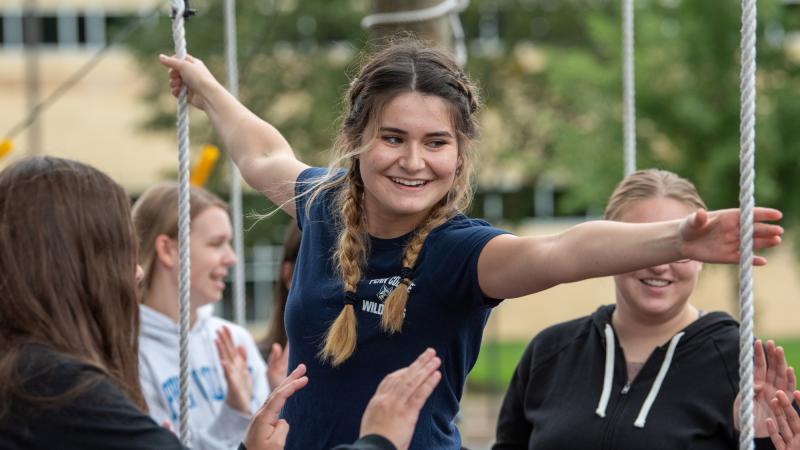Members of the Student American Dental Hygienists Association are led by Rob Cooley, bottom right, who initiated the Fish Real Estate Leadership Challenge Course, through an activity that uses a large “webbing loop” to form a circle. The group begins standing, and first leans back while holding the loop. “The collective balance of the group depends on everyone working together and trusting each other,” Cooley says. Once comfortable with leaning, the group sits and rises in unison.
Leadership Challenge Course transforms individuals to teams
Published 09.19.2022

by Cindy Meixel
Writer/Editor Penn College News
Devin Boyd-Joseph says he didn’t really get to know his classmates until he set foot on the Fish Real Estate Leadership Challenge Course. It was the sixth week of classes in Fall 2021, and the Hanover resident joined with other automotive technology: Honda PACT students at the outdoor venue on the south edge of campus.
“Up to that point, it felt like we barely knew each other, but out there, we got to know each other – more than in the classes. It was nice learning about everybody, communicating, and getting to know about our different lives and backgrounds,” Boyd-Joseph said. “It was different from team building I’d done in the past.”
The pressure of a challenge allows you to see a vulnerable side of people but also highlights their inner strength!
Nearly 400 students engaged in team-building exercises during the 2021-22 academic year at the new Challenge Course. A diverse array of academic majors took advantage of the unique offering, as did student organizations, athletics teams and a range of college departments. The current academic year will no doubt see renewed enthusiasm and increased engagement at the hands-on enterprise.
“The course presents an opportunity for members of our campus community to step outside of their comfort zone by engaging in challenging and fun leadership and team-building activities,” said Brenda Wiegand, associate director of academic operations and a course facilitator.
Featuring nine elements ranging in physical difficulty, the 14,400-square-foot Challenge Course focuses on collaboration and problem-solving, explores leadership and communication concepts, and encourages self-discovery and team growth. Strengthening relationships as well as self-confidence are key outcomes, and those resulting benefits follow participants off the course into their classrooms, labs and lives.
“I encountered course participants across campus after their sessions and learned that some of the skills they applied during their experience (communication, respect, collaboration, support) continued to influence their work and peer groups long after the challenge course event,” said Rob Cooley, associate professor of anthropology/environmental science.
Cooley initiated and shepherded the Challenge Course after witnessing countless transformational experiences among students on study-abroad expeditions and in his Outdoor Recreation as a Therapeutic Tool course. During a Spring 2019 sabbatical, he researched and consulted with Tony Draus, of EdVenture Builders in Bloomsburg, and the duo brought the vision to life – with the added expertise of faculty and students in architecture and building construction technology and Penn College General Services employees. Boosting the endeavor financially were Brent and Daria Fish, who generously gifted support to honor the memory of Brent’s father, William H. Fish. It’s been a true team effort that has resulted in a ripple effect of infinite opportunities.
“It was special for me to see participants experience in real time the surprising, unexpected personal insights that come from challenge and team-building experiences,” Cooley said. “I really appreciated seeing groups coalesce during their experience: Individuals would arrive at the course for their program as individuals, standing alone and looking at their phone, or chatting in groups of two or three, but leaving in larger groups, laughing, talking about what just happened.”
Other faculty have taken notice, scheduling Challenge Course sessions for their students.
“It was wonderful watching the students connect outside of the classroom and clinic environment,” said Bridget E. Motel, dental hygiene instructor. “I saw them encourage each other as they worked together to navigate the course obstacles and complete the unique problem-solving exercises. Students developed their leadership, teamwork and critical thinking skills in a fun, friendly environment. Both first- and second-year students truly enjoyed this experience and appreciated the opportunity to interact!”
Joe Tavani, instructor of automotive technology: Honda PACT, says he sought out the Challenge Course for his students as a way to infuse a teamwork component into what is otherwise a fairly solitary career field.
“In the automotive business and, in general, a lot of trades, you’re not in a teamworking situation; you’re doing your job solo. For the most part, you’re alone in your day, and if you lose focus, you make mistakes. I thought the Challenge Course would contribute to their learning, in seeing how other people’s points of view help in solving problems,” Tavani explained.
With the outdoor venue launching during the COVID-19 pandemic, the Challenge Course offered additional healthy benefits.
“The Challenge Course was a place where positivity and fresh air eased the stress from masking, COVID-19 and the world, and allowed people to just be their best selves, pushing boundaries, learning about others, and making authentic connections with people in their major, team or group that they might not have ever really engaged with otherwise,” Cooley said.
Jorden Graham, a human services & restorative justice student from Williamsport, concurred: “I was excited to be outdoors and get to know my peers’ smiling faces. What surprised me was the experience of learning different working styles. We each applied our unique key strengths as a cooperative force, which was fun and enlightening. The pressure of a challenge allows you to see a vulnerable side of people but also highlights their inner strength!”
The Challenge Course has also adeptly stirred laughter into the learning.
“Everyone worked together through laughter and collaboration,” said Samantha Theriault, a dental hygiene student from Taylor. “Even those who came with apprehension left with a team spirit and enjoyed their time! Taking time to build relationships with my classmates outside of the classroom benefitted our relationships from that point on.”
Starting each session with icebreaker games and evolving into activities requiring physical support between participants, the Challenge Course creates experiences where the individual’s and team’s success and physical safety depends on the participants collaborating directly and intentionally.
“As a facilitator, I have found that one of the most impactful parts of the course is the opportunity to debrief activities with participants,” Wiegand said. “Through these reflection activities, it’s easy to see the value the course provides. Some of the comments I hear participants say are: ‘I can’t believe I just did that!,’ ‘No one has ever cheered for me like that before,’ or ‘I didn’t realize I could lead.’”
Elements of the Challenge Course
Wildcat Walk
Get your group to safely traverse multiple lengths of cable without falling off. There are trees and poles between the stretches of cable, which help, but moving between trees can be challenging. Communication and trust are key to success here.
Z Steps
Similar to the Wildcat Walk, but this activity uses planks instead of rope. The added challenge here is that trees or poles are off-limits as supports.
Commitment Bridge
This is a trust-building activity. Team members pair up and stand facing each other at the intersection of two cables strung into a “V” shape. The pair holds hands or locks arms and shuffles outward on the cables as the cables get farther apart. As the participants progress along the widening V, they will lean increasingly on each other.
Tire Traverse
A very physical element. The goal is to get your group across the course from one tire to the next without touching the ground.
Triangle Tension Traverse
This is a low-profile but challenging station! It begins easily, but the difficulty is increased quickly as participants traverse.
Team Nitro Crossing
Teams swing across an imaginary canyon using one rope and four platforms. The basic rule of this station is that the hazard will consume the life support tools (rope, platforms) if participants let go or stop touching those items.
Postman Walk
This tightrope-like activity involves a two-line bridge with one rope as a handrail.
Multiline
This element involves dangling support ropes that are hung at various heights and lengths. Your team will climb these ropes simultaneously.
Porthole
Everyone has to escape a sinking ship via the porthole to the lifeboat. Team members will pass through a tire with some added difficulties.

